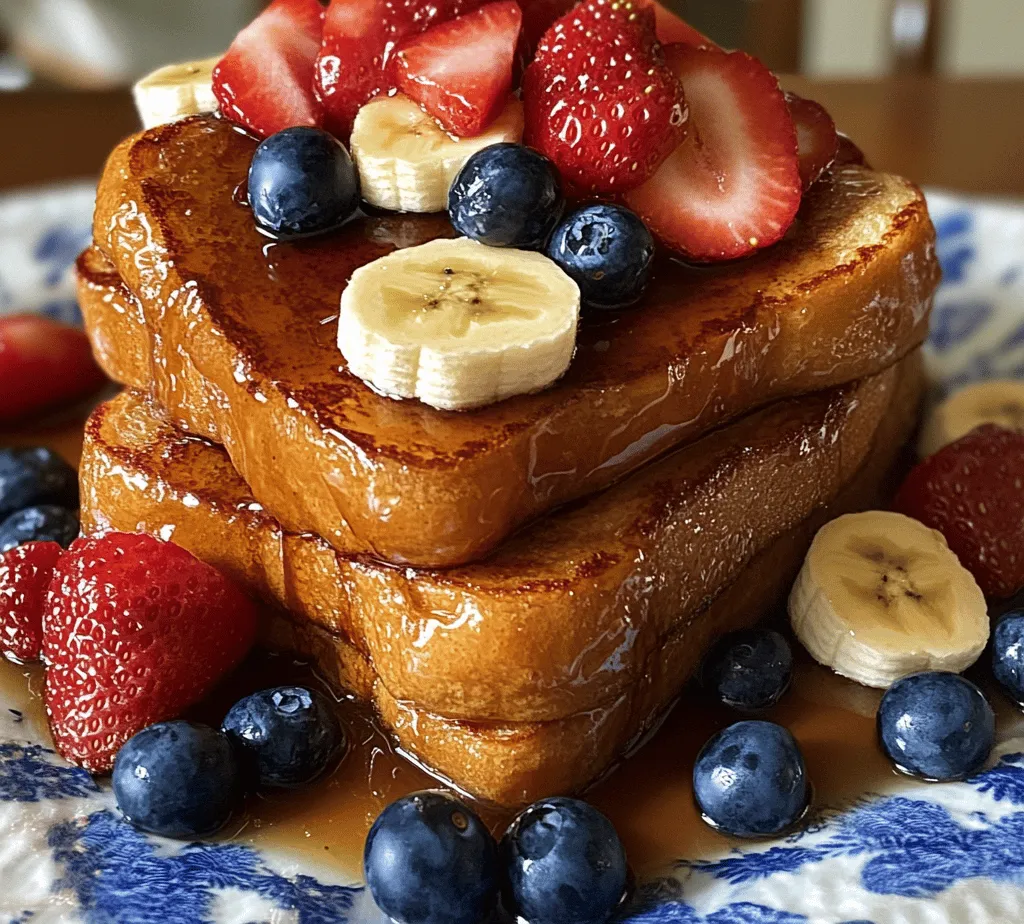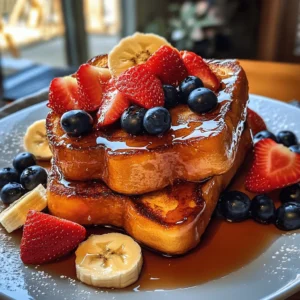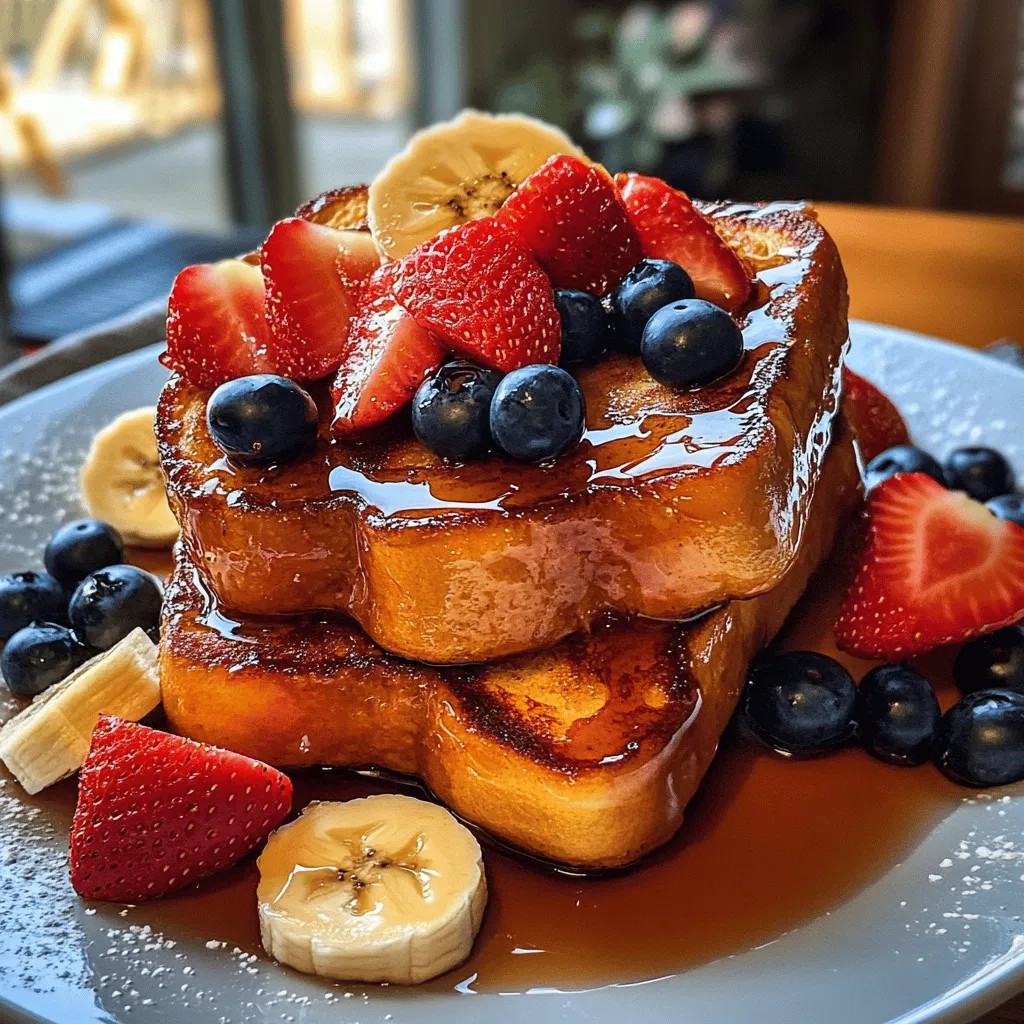Introduction
French toast is a breakfast classic that has earned its place in kitchens around the world. This beloved dish, known for its golden-brown exterior and soft, custardy interior, is a go-to choice for many families, especially on leisurely mornings. But what if we could elevate this simple dish to a whole new level? Enter caramelized French toast—a delightful twist that adds a rich layer of flavor and texture, making every bite an indulgent experience.
Caramelization transforms the ordinary into the extraordinary, creating a sweet, crispy crust that beautifully contrasts with the tender bread inside. Imagine sinking your fork into a piece of French toast that glistens with caramelized sugar, each bite bursting with warmth and sweetness. This recipe not only satisfies your morning cravings but also impresses guests, making it perfect for brunch gatherings or special occasions.
One of the most appealing aspects of caramelized French toast is its simplicity. With just a few basic ingredients and minimal preparation time, even novice cooks can master this recipe. Whether you’re a seasoned chef or someone who rarely steps into the kitchen, this dish is accessible and enjoyable to make. Let’s dive into the details of what you’ll need to create this culinary delight and the step-by-step process to bring it to life.
Understanding the Ingredients
Creating the perfect caramelized French toast begins with understanding the key ingredients. Each component plays a vital role in achieving the dish’s signature flavor and texture, so let’s explore them in detail.
The Bread Choice
The foundation of any French toast recipe is the bread, and for caramelized French toast, the choice of bread is critical. Thick, hearty slices are essential for two reasons: they absorb the egg mixture without falling apart, and they provide a satisfying chewiness that complements the caramelization.
Brioche and challah are two popular options that shine in this recipe. Brioche, a rich and buttery bread, offers a slightly sweet flavor and a soft, airy texture. Its delicate crumb absorbs the egg mixture beautifully while maintaining its structure during cooking.
On the other hand, challah—a traditional Jewish bread—features a slightly denser texture and a slightly sweet, eggy flavor. Its braided appearance not only makes for an aesthetically pleasing presentation but also enhances the overall eating experience. Both breads have their unique qualities, and your choice may depend on personal preference or availability.
In summary, using thick slices of brioche or challah is crucial for achieving that perfect balance of soft insides and a caramelized crust on the outside.
Eggs and Dairy Base
Eggs are a cornerstone of French toast recipes, providing structure and richness. When whisked together with milk, they create a custard-like mixture that envelops the bread and infuses it with flavor. The type of milk you choose can significantly affect the final dish, so it’s worth considering your options.
Whole milk is a popular choice, as its creaminess enhances the richness of the egg mixture, resulting in a decadent bite. However, for those with dietary restrictions or preferences, almond milk or other plant-based alternatives can be used without compromising the flavor. While almond milk offers a subtle nuttiness, it may create a slightly different texture compared to whole milk, so keep that in mind when making your selection.
Sweetening and Flavoring Agents
To elevate the flavor profile of your caramelized French toast, it’s essential to incorporate sweetening and flavoring agents. Sugar is the primary sweetener, and understanding the difference between white and brown sugar can help you achieve the desired taste.
White sugar provides straightforward sweetness, while brown sugar adds depth and complexity due to its molasses content. For caramelized French toast, brown sugar is a fantastic option, as it caramelizes beautifully, imparting a rich flavor to the crust.
In addition to sugar, vanilla extract and ground cinnamon are indispensable in this recipe. Vanilla enhances the overall flavor, infusing the French toast with a warm, inviting aroma. Meanwhile, cinnamon adds a touch of warmth and spice, making each bite even more delightful. A pinch of salt is also essential, as it balances the sweetness and brings out the other flavors.
Cooking Fat
The cooking fat you choose can significantly impact the flavor of your caramelized French toast. Butter is the traditional choice, known for its rich flavor and ability to create that coveted golden crust. When heated, butter helps caramelize the sugar on the bread, resulting in a deliciously crispy exterior.
For those seeking non-dairy options, there are plenty of alternatives. Coconut oil or vegan butter can be used instead, providing a similar richness without dairy. Each option brings its unique flavor, so feel free to experiment to find the one that suits your taste best.
Step-by-Step Guide to Making Caramelized French Toast
Now that we’ve covered the essential ingredients, let’s move on to the exciting part—making caramelized French toast! Follow these detailed steps to ensure a successful and delicious outcome.
Preparation of the Egg Mixture
To start, gather all of your ingredients and equipment. You’ll need a mixing bowl, a whisk, a skillet, and a spatula. Begin by cracking the eggs into the mixing bowl; typically, 2-4 eggs are sufficient, depending on how many servings you plan to make. Whisk the eggs until well combined.
Next, add in your chosen milk—about a cup should suffice. If you’re using whole milk, you’ll enhance the richness, while almond milk offers a lighter alternative. Continue whisking until the mixture is smooth and creamy. This is also the point where you’ll want to add your sweeteners and flavorings: 1-2 tablespoons of brown sugar, a splash of vanilla extract, and a sprinkle of ground cinnamon. Whisk these ingredients in until fully incorporated.
The result should be a luscious, custardy mixture that will soak into the bread, infusing each slice with flavor.
Heating the Skillet
Once your egg mixture is ready, it’s time to heat the skillet. Place a non-stick skillet or griddle over medium heat and allow it to warm up for a few minutes. To test if the skillet is hot enough, sprinkle a few drops of water onto the surface; if they sizzle and evaporate quickly, you’re ready to go.
Add a generous pat of butter (or your chosen cooking fat) to the skillet, allowing it to melt and coat the surface evenly. The right temperature is crucial here—too low, and your French toast will absorb too much egg mixture without cooking properly; too high, and the outside will burn before the inside is set.
Coating the Bread
Now comes the fun part—coating the bread! Take your thick slices of brioche or challah and dip them into the egg mixture one at a time. Ensure each slice is fully submerged, allowing it to soak for just a few seconds. Be cautious not to let the bread sit too long in the mixture, as this can lead to sogginess.
After coating, let any excess egg mixture drip off before placing the slices in the hot skillet. This step is essential for achieving a perfectly caramelized crust.
Cooking the French Toast
With your bread slices coated and the skillet ready, it’s time to cook the French toast. Carefully place the soaked slices into the skillet, ensuring they are not overcrowded; this will allow for even cooking and caramelization. Cook for about 3-4 minutes on one side until it turns a beautiful golden brown.
Once the first side is cooked, gently flip the French toast using a spatula. You should see a lovely caramelized crust starting to form. Cook the other side for another 3-4 minutes, adjusting the heat if necessary to avoid burning.
As the French toast cooks, the sweet aroma will fill your kitchen, drawing everyone in. The anticipation will build as you watch the caramelization process unfold, resulting in a visually appealing and delicious breakfast dish.
Stay tuned for the next part of this article, where we will delve deeper into serving suggestions, tips for perfecting your caramelized French toast, and answers to common questions about this delightful breakfast treat!

Timing and Visual Cues for Perfect Browning
Achieving the perfect caramelization on your French toast is all about timing and recognizing visual cues. When cooking, it’s important to keep an eye on the color of your toast. Begin by preheating your skillet or griddle over medium heat. You want a hot cooking surface that allows for the sugars in the batter to caramelize beautifully without burning.
As the toast cooks, look for a golden-brown color starting to develop on the edges. This typically takes about 3-5 minutes per side, depending on the thickness of the bread and the heat level. Once you see that lovely golden hue, it’s time to flip! The caramelization process should create a slight crust that adds flavor and texture, while the inside remains soft and custardy.
Explanation of the Caramelization Process Using Additional Sugar
Caramelization occurs when sugar is heated, causing it to melt and turn into a rich, golden syrup. For French toast, this process can be enhanced by adding a sprinkle of sugar directly to the cooking surface or mixing a touch of brown sugar into your egg mixture.
Brown sugar, due to its molasses content, not only enhances the sweetness but also contributes to a deeper flavor profile. When this sugar comes into contact with the hot skillet, it melts and forms a deliciously sweet caramel crust on the surface of the bread.
To achieve optimal results, watch for bubbling and the aroma of sweet caramel as these are signs that the sugar is beginning to caramelize. If you find your toast is browning too quickly or burning, reduce the heat to allow for a more even cooking process.
Serving Suggestions
Once your caramelized French toast is ready, the possibilities for serving are endless. Here are some delicious suggestions to elevate your breakfast experience:
1. Classic Toppings: Drizzle with pure maple syrup for a traditional touch. The rich, sweet flavor pairs perfectly with the caramelized notes of the toast.
2. Fresh Fruits: Top with seasonal fruits such as strawberries, blueberries, or bananas. The freshness of the fruit contrasts beautifully with the richness of the French toast, adding color and nutrition.
3. Whipped Cream: A dollop of freshly whipped cream can turn your breakfast into a decadent treat. For added flavor, consider folding in vanilla or a hint of cinnamon into the cream.
4. Nuts and Seeds: For a crunchy texture, sprinkle some toasted nuts or seeds on top. Walnuts, almonds, or even chia seeds can add a nutritious element while enhancing the overall flavor profile.
5. Yogurt or Cream Cheese: A smear of cream cheese or a spoonful of Greek yogurt can add a tangy contrast to the sweetness of the French toast, making it a delightful combination.
Presentation Ideas for a Visually Appealing Dish
Presentation is key when serving French toast, especially if you want to impress your guests. Here are a few ideas to make your dish visually appealing:
1. Layering: Stack two or three slices of French toast on a plate. This not only looks appealing but also gives a hearty serving.
2. Garnishing: Use fresh mint leaves or edible flowers for a pop of color. A light dusting of powdered sugar can also add a touch of elegance.
3. Serving on a Board: Consider serving the French toast on a wooden board with small bowls of toppings. This interactive approach allows guests to customize their plates.
4. Creative Plating: Use a swirl of syrup or a sprinkle of cinnamon powder around the plate to create an artistic look.
Nutritional Insights
Caloric Breakdown
While caramelized French toast is undeniably delicious, it’s important to be aware of its nutritional content. A standard serving of French toast made with eggs and milk generally contains around 300-400 calories, depending on the type of bread used and the toppings added.
A typical slice made with enriched white bread contributes significantly to the calorie count, while whole grain options may offer more fiber and nutrients.
Overview of the Nutritional Value per Serving
In addition to calories, consider the other nutritional components:
– Protein: The eggs in the recipe provide protein, essential for muscle repair and overall health. Each slice may contain around 6-8 grams of protein.
– Carbohydrates: Depending on the bread chosen, carbohydrates can range from 30-50 grams per serving, providing quick energy.
– Fats: If butter is used for cooking, the fat content will increase. However, opting for a non-stick pan can reduce the amount of added fat.
– Vitamins and Minerals: Whole grain bread offers additional vitamins and minerals, contributing to a balanced diet.
Healthier Alternatives
To make your French toast a bit healthier, consider these alternatives:
1. Reduce Sugar: You can cut down on sugar by using less in your egg mixture or opting for natural sweeteners like honey or agave syrup.
2. Use Whole Grain Bread: Choosing whole grain or whole wheat bread can significantly increase the fiber content and overall nutritional value of your dish.
3. Almond or Coconut Milk: If you’re looking to lower calories or avoid dairy, almond or coconut milk can be great substitutes for regular milk.
Balancing Indulgence and Nutrition
Enjoying caramelized French toast can certainly be part of a balanced diet. The key is moderation. Incorporating this delightful dish into your breakfast rotation allows you to savor a treat while still focusing on overall nutrition throughout the day. Pairing your French toast with a side of fruit or a protein source can create a more balanced meal.
Cultural Variations of French Toast
Global Takes on French Toast
French toast is a beloved dish around the world, with each culture adding its unique spin. Here are a few global variations:
1. Pain Perdu (France): This classic French version translates to “lost bread,” referring to the use of stale bread. It’s often soaked in a mixture of eggs, milk, sugar, and sometimes flavored with orange or vanilla.
2. Eggy Bread (United Kingdom): In the UK, French toast is known as “eggy bread” and is often served as a savory dish, sometimes with beans or bacon.
3. Torrija (Spain): Similar to pain perdu, torrija is typically enjoyed during Lent. It’s soaked in syrup or wine and often topped with cinnamon and sugar.
4. Arme Ritter (Germany): This German version uses day-old bread and is typically flavored with vanilla and sugar, served with fruit compote.
Common Mistakes to Avoid
Over-soaking the Bread
One common mistake when making French toast is over-soaking the bread. While it’s essential for the bread to absorb the egg mixture, too much time in the mixture can lead to a soggy texture. Aim for around 30 seconds per side for thicker slices and adjust based on the bread type and thickness you are using.
Not Caramelizing Properly
Failing to achieve a proper caramelization can result in a bland French toast. Ensure your skillet is adequately heated before adding the bread. If the temperature is too low, the sugars won’t caramelize effectively. Conversely, if the heat is too high, you risk burning the outside while the inside remains uncooked.
Skipping the Right Bread
The type of bread you choose plays a significant role in the success of your French toast. Avoid using very soft or flimsy breads, as they may fall apart. Opt for thicker slices of brioche, challah, or even sourdough for the best results. These breads hold up well during cooking and provide excellent flavor and texture.
Conclusion
Caramelized French toast offers a delightful combination of crispy, sweet, and soft textures that transforms a classic breakfast dish into a gourmet experience. With the right technique and attention to detail, you can create a breakfast that not only satisfies your taste buds but also impresses your family and friends.
Don’t hesitate to experiment with various flavors, toppings, and presentation styles to make this dish your own. Whether you choose to keep it classic with maple syrup or go all out with fresh fruits and whipped cream, each rendition will be a delicious treat.
Remember, cooking is as much about creativity as it is about following recipes. So indulge occasionally, savor the flavors, and enjoy the process of making and sharing this delightful caramelized French toast!


